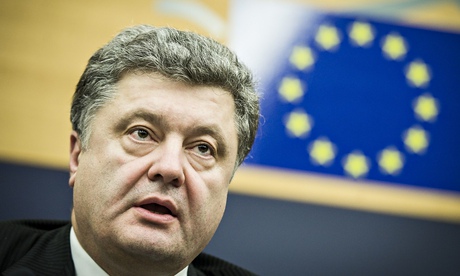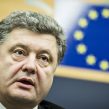
Ukraine’s Presidential Election Reveals Unexpected Trends
Publication: Eurasia Daily Monitor Volume: 11 Issue: 101
By:

Ukraine’s president-elect, billionaire Petro Poroshenko, has received a broad popular mandate to promote closer relations between Ukraine and the European Union. On May 25, Poroshenko won 55 percent of the vote in the first round of a crowded presidential race (his score avoided a runoff). Poroshenko ran with the support of Vitaly Klichko’s UDAR party, after Klichko had desisted in his favor. Poroshenko positioned himself clearly as a Western-oriented candidate, albeit one who can also confidently handle difficult relations with Russia (see EDM, May 27).
Poroshenko campaigned with a clear-cut pro-Europe message. For the first time since Ukraine became independent, the majority of Ukraine’s voters opted clearly for Europe in this presidential election.
Former prime minister Yulia Tymoshenko was a distant runner-up at 13 percent; and former defense minister Anatoliy Hrytsenko received 6 percent. They both support Ukrainian association with the EU and membership in the North Atlantic Treaty Organization (NATO).
In all, therefore, some 75 percent of the total votes cast in Ukraine’s presidential election accrued to presidential candidates with clear Western-oriented messages.
Voter turnout was 60.2 percent on a country-wide basis in this election: higher in the west and center, lower in the east and south of the country (and minimal in conflict-torn Donbas). The overall turnout of 60 percent country-wide amounts in itself to a rejection of Moscow’s efforts to disrupt the election (Interfax-Ukraine, UNIAN, Ukraiynska Pravda, May 26 , 27).
Four years earlier, the voter turnout had been 67 percent in the first round of Ukraine’s 2010 presidential election. Apparently, the rebels’ closure of the polling places in Donbas accounts for at least a part of the 7 percent drop in voter turnout from 2010 to 2014. If so, it would follow that Moscow’s televised calls to boycott the 2014 election were poorly heeded outside Donbas.
Communist Party leader Petro Symonenko (a perennial presidential candidate; winning 3.5 percent of the vote in 2010) and Party of Regions parliamentary deputy Oleg Tsaryov (self-nominated, and therefore expelled from the party) registered on the ballot, but they withdrew from the race during the pre-election campaign. They followed Moscow’s guidance to withdraw in order to reduce voter turnout, hoping thereby to de-legitimize the election of a Ukrainian president. Tsaryov, a Russian nationalist a-typical for the Party of Regions, called on all candidates to withdraw from the election, and he went on to lead the extra-parliamentary Novorossiya movement.
In the event, Serhey Tyhypko, Party of Regions parliamentary deputy and self-nominated presidential candidate (a nationally-minded Ukrainian) received 5 percent of the vote on May 25; former Kharkiv governor Mykhailo Dobkin, the Party of Regions’ official candidate, won 3 percent (he supports all pro-Russia positions, but backtracked from “federalization”); and Communist leader Symonenko (in absentia—see above) garnered 1.5 percent of the ballots cast.
Seen in light of those numbers, Poroshenko’s presidential victory is actually a landslide. Aggregate support for pro-Western candidates, at three quarters of the total number of votes cast, looks remarkably high. Unlike previous Ukrainian presidential elections, voters this time did not polarize along an east-west divide. Poroshenko won country-wide as a unifying factor (except in conflict-ravaged Donbas). By the same token, voters showed a low level of interest in pro-Russia positions (such interest could grow, however, with a more charismatic candidate such as Tsaryov).
No serious candidate positioned himself as leaning toward Russia in this Ukrainian presidential election. Again, this stands in contrast to Ukraine’s previous presidential elections, when a candidate at least perceived as Russia-friendly always advanced to the runoff and usually won (Symonenko, Kuchma, Yanukovych). Kremlin connections and Russian media support were major assets in all of Ukraine’s presidential elections. The election just held, however, has marked a turning point in this regard also.
This election has dispelled the Kremlin’s construct of “Novorossiya” or “South-Eastern Ukraine” as a would-be political entity under Russia’s protection. Moscow proposes to create such an entity and to designate its representatives in a federal, confederal, or secession scenario against Ukraine. Of those eight provinces (oblasts) in Ukraine’s south and east, however, six (i.e., other than Donetsk and Luhansk) gave Poroshenko majorities or solid pluralities, with voter turnouts averaging close to 50 percent, despite Moscow’s efforts to discredit the election particularly in the southern and eastern provinces.
Oleh Tyahnybok, leader of the right-conservative Svoboda Party (component of the coalition government in Kyiv) and Dmytro Yarosh, leader of the militant Right Sector, also ran in this presidential election. Each of them received approximately 1 percent of the votes cast. Their scores lay to rest Moscow’s thesis about “fascism” overtaking Ukraine.
Svoboda’s and Right Sector’s combined score of some 2 percent, meanwhile, is ten times less than some of Moscow’s new-found radical-right allies scored in the elections to the European Parliament, held concurrently with Ukraine’s elections on May 25. Naively, Svoboda and Right Sector had earlier attempted to court the French National Front and Hungarian Jobbik, on the presumption of ideological affinities. Yet these parties have recently sided with the Kremlin in propagandizing against Ukraine.




